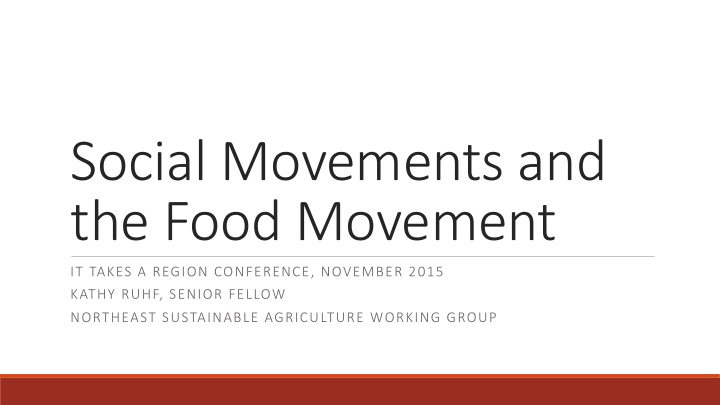



Social Movements and the Food Movement IT TAKES A REGION CONFERENCE, NOVEMBER 2015 KATHY RUHF, SENIOR FELLOW NORTHEAST SUSTAINABLE AGRICULTURE WORKING GROUP
Wha What is a so t is a social mo ial movemen ement? t? § Consciously formed associa1on whose goal is to bring about change in social, economic or poli1cal sectors through collec1ve ac1on and mobiliza1on of large numbers of people. § Involved in conflictual rela1ons with clearly iden1fied opponents; linked by dense informal networks; share a dis1nct collec1ve iden1ty. § Organized yet informal social en11es that are engaged in extra- ins1tu1onal conflict that is oriented towards a goal. These goals can be either aimed at a specific and narrow policy or be more broadly aimed at cultural change.
Th The “F e “Food ood M Movemen ement” or ” orien entaNon on • Inclusion : get marginalized players in ; immigrant farmers, food access • Reforma/on : alter opera1ng guidelines ; farmers market rules, fair trade, beFer farm leases • Transforma/on : establish qualita1vely different paradigms ; food as human right, land as commons
Po Power of social movements • Poli1cal opportuni1es • Framing processes • Mobilizing structures
Po PoliNcal opportuniNes • Openings for change within poli1cal structures • Interface with exis1ng structures and strategic posi1oning • e.g., Clean Water Act, USDA Office of Advocacy and Outreach
Mo Mobilizing s bilizing struc tructur tures es • Forms and tac1cs that movements take • Organiza1onal capacity to mobilize; what is capacity (resources, exper1se, technology)? • Many groups à hard to coordinate; compete • Many groups also means resilience, diversity, tes1ng various tac1cs and experiments
Fr Framing pr aming processes cesses • Shared meanings and defini1ons that describe the problem, causes and solu1ons • The power or mobilizing capacity of a frame is how strongly it resonates and compels ac/on ◦ credibility : testable, and significant to everyday life ◦ resonance : corresponds to life experience and meaning ◦ something can be credible, but lack resonance
His Historic orically d ally domin ominan ant fr frames in ames in agri agri-f -food work • Environmental sustainability: historically “sustainable ag”; WQ/natural resources, GMO, land use • Economic jus1ce (for farmers): concentra1on, viability, tenure, markets • Community food security: food access; food jus1ce/rights, for consumers; local economies • Health and food safety: nutri1on, diet, GMO—not necessarily 1ed to agriculture
Mas Master Fr er Frames ames • Frames vary in their comprehensiveness • Master frame is most inclusive • A unifying message that brings together various sub- issues, orgs, networks within a social movement • Civil rights • Sustainable ag v. CFS • Has the greatest poten1al to resonate and mobilize
Mas Master fr er frames ames • What is our master frame??? • Is there a BIGGER master frame? • Sustainable Community Movement? • Domes1c economic dispari1es • UN Sustainable Development Goals? • “ Substan1al things” – jus1ce, ecology, equity, democracy, diversity, opportunity
Str Strategic gic Orie rientaNo aNon • How do you see your own work? • How would you characterize your organizaNon’s work? • What is the opNmal balance for your movement goals to be achieved?
Str Strategic gic orie rientaNo aNon: n: Warrio arrior r work rk Resistance = Change poli1cal & economic structures ◦ Challenges primarily in poli1cal sector ◦ Defends ground gained ◦ Effec1ve to mobilize: public protest is highly visible ◦ Can be in the trenches: NSAC and the farm bill ◦ Creates space for weaver work
Str Strategic gic orie rientaNo aNon: n: Builde uilder r Work rk Reconstruc1on = Create alterna1ves • New models e.g., CSA, new genera1on coops, carbon credits • Changes primarily in market sector • Less conten1ous • May not see as conscious resistance • Entrepreneurial, precarious
Str Strategic gic orie rientaNo aNon: n: Weaver r Work rk Connec1on = linking to foster change • Primarily in the civil sector • Networks, coali1ons; movement-building • Intra-sectoral: within specific area (e.g., organizing producer coops) • Inter-sectoral different interests (e.g., Food Policy Councils) • Horizontal and ver1cal
Wha What t is is ou our mo r movemen ement? ? Wha What is t is yo your w work? ork? • How can we beFer understand and analyze our work to build the movement”? • What strategic connec1ons need to happen to advance our movement? • What is your “strategic orienta1on”? (see handout) • How does our individual work contribute to the movement?
Th Thank y you ou! Kathy Ruhf Senior Fellow, Northeast Sustainable Agriculture Working Group kzruhf@Verizon.net Warrior, Builder and Weaver Work: Strategies for Changing the Food System From: Remaking the North American Food System: Strategies for Sustainability C. Clare Hinrichs and Thomas A. Lyson, editors University of Nebraska Press, 2007
Recommend
More recommend